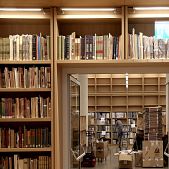
The transfer of the collections from the National Library to its new facilities at the Stavros Niarchos Foundation Cultural Center
The National Library of Greece is the principle custodian and steward of Greece’s intellectual heritage.Its story begins in 1829, almost parallel to the establishment of the Greek State under the Governor of Greece, Ioannis Kapodistrias. Dating back to 1903, The National Library of Greece is housed in the iconic Vallianio building, on Panepistimiou Street, where it has uninterruptedly operated throughout the 20th century.
The donation of the Stavros Niarchos Foundation, together with an extraordinary grant from the Greek State, is propelling the National Library of Greece into a new period of modern and exemplary operation, as it relocates to its new facilities at the Stavros Niarchos Foundation Cultural Center. The relocation is not a mere transfer of books from one building to another; it is the transition of the institution into a new era.
The relocation is a historical project that requires the cooperation of hundreds of people and several organizations, all called upon to transcend, to overcome the difficulties of the past and build strong foundations for the future.For months, experts have been processing the 750,000 items of the library’s general collections and the 15,000 items of its rare materials collection, one by one.

This complex work has many stages: restoration, preventative maintenance, isolation of biologically damaged materials, digitization of book covers, backlog cataloguing and bibliographic registration within the new digital database, identification of information and radiolabeling. The goal of this process is the total assortment of the library’s collections, so that they may be safely relocated and easily accessed by any interested person.
The transfer of collections is a very difficult and complicated project, as their maximum safety must be ensured. Packaging and transport comply with international practices. All departments of the National Library participate in the implementation of the project and its coordination has been undertaken by the Interactive Transport Group, consisting of civil engineer, book and archival material maintainers and administrative staff.
The transport is mainly done with cart – libraries suitably designed to absorb vibrations and avoid displacements of the material. Plastic and wooden boxes, as well as cartons, are also used. Where there are stairs and staircases, special ramps are used with a suitable gradient for the safe movement of library carts.
The process of transferring the collections from the libraries is as follows: each rack is electronically identified and immediately placed in the wheeled library. Each wheeled library is filled, closed, sealed under the supervision of an employee of the National Library, placed in a truck with controlled climatic conditions, and finally transferred to the new facilities accompanied by an employee of the National Library. It is then repositioned and rechecked. Please note that the Library maintainers oversee and provide additional instructions to the work groups during the execution of the project.
As far as the special collections, the rare and precious manuscripts and archives are concerned, they will be stored in four vaults under appropriate conditions of temperature, humidity, lighting and security.
At the same time, after decades, the National Library of Greece is acquiring books from the international marketplace and gaining access to scientific digital databases. The establishment of the Public Library Section renders anew a connection to new technology and a new generation of readers. In line with modern trends in research and information, the transition into an era of innovation and openness entails the upgrading of infrastructure and digital service systems, the training of staff, and the gradual operation of new departments in the new building.
The nearly 24,000 m2 (235,000 sq. ft.) state-of-the-art building combines traditional with technological innovation, conservation with information and communication. The flexibility of its design, informed by consultations with the prominent British Library (www.bl.uk), ensures that the National Library can respond effectively to ever-changing needs and the challenges of the digital age. A nationwide digitization project will help make heritage materials available to the public and will offer access to the Library’s various collections. Connectivity with other libraries both nationally and globally will allow the Library’s users access to material abroad that is relevant to Greece or Hellenism. In addition, a Business Center will provide the public with an active hub for enterprise, knowledge, and innovation, offering computer workstations, laptops, and wireless connectivity.
Sources: transition.nlg.gr, www.snfcc.org / Photos: AMNA
























